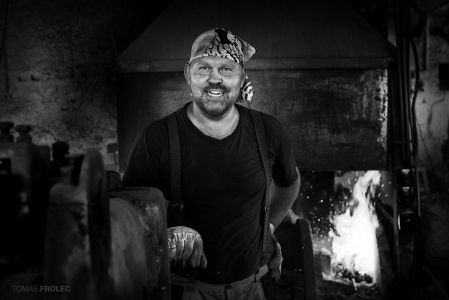Tamahagane weekend 25-26 March 2022
Tamahagane weekend 25-26 March 2022.
At the end of February I met with my friends Bitner and Loki and the guys from Knife Z vostra at our place in Pálovice to test the new kiln for tamahagane production. For the reduction we used iron sand, a magnetite of extremely high chemical purity, as the raw material. We smelted in two furnaces. The first one, already tested several times in the past, is made of refractory steel with a fireclay lining with an inner circular diameter of about 40 cm. The air is blown in by one pump. Load approx. 30 kg of satetsu and 110 kg of charcoal. Reduction time approx. 3 hours without preheating the kiln. The furnace was operated by Bitner. Two melts were carried out. Result of kera approx. 13 kg in the first melt, two compact kera with a total weight of approx. 12 kg in the second melt. In the second smelting, the charge was a combination of satetsu and partially reduced ore from the previous smelting in a large tare. Basically it is magnetite reduced to hematite, which was crushed into small segments of 3 - 1 mm. This material is easier to reduce. This was very noticeable when the slag was repeatedly tapped, which was completely liquid and flowed out of the tapping hole at the bottom of the tartar in a strong stream. When pure magnetite was used, the slag was much denser and flowed out lazily and in smaller quantities.
The second oven was brick, square base, wall length approx. 60 cm. During the first melting the air was blown in by two air pumps, during the second melting by one air pump. The charge was approx. 40 kg of satetsu and 150 kg of charcoal. Reduction time approx. 4 hours. The furnace was operated by Loki. The first smelting resulted in 4 kera, one high carbon, almost cast iron and three smaller compact kera of high quality high carbon tamahagane weighing 3-5 kg each. The second one-pot smelting was carried out very carefully with minor changes based on the results and experience of the first, test smelting. The result was a huge kera of approx. 20kg and one smaller compact kera of approx. 3kg. The large brick is compact, made up of high carbon steel. There is a smaller protrusion at the top which has not been fully reduced by the ferrous sand. This part of the bark shows the process of reduction, the conversion of iron oxide into steel.
In the second bet, the steel was reduced in almost 70% of the weight of the satetsu used. I consider a reduction with a 30% yield to be successful and usually the results are around 40 - 50% yield due to the extremely high quality of the ore.
Thanks to smelters Bitner and Loki and the boys from Knife z vostra for their assistance and help. This time I enjoyed the positions of observer, picker, tonger and advisor and served only the grill. Special thanks also to Pavel Holub, who recorded the event and will produce a documentary on it. And of course thanks to Zuzana for her service, background and tolerance of the excesses of the boys playing. And to the assistants Morgana and Sheno.
